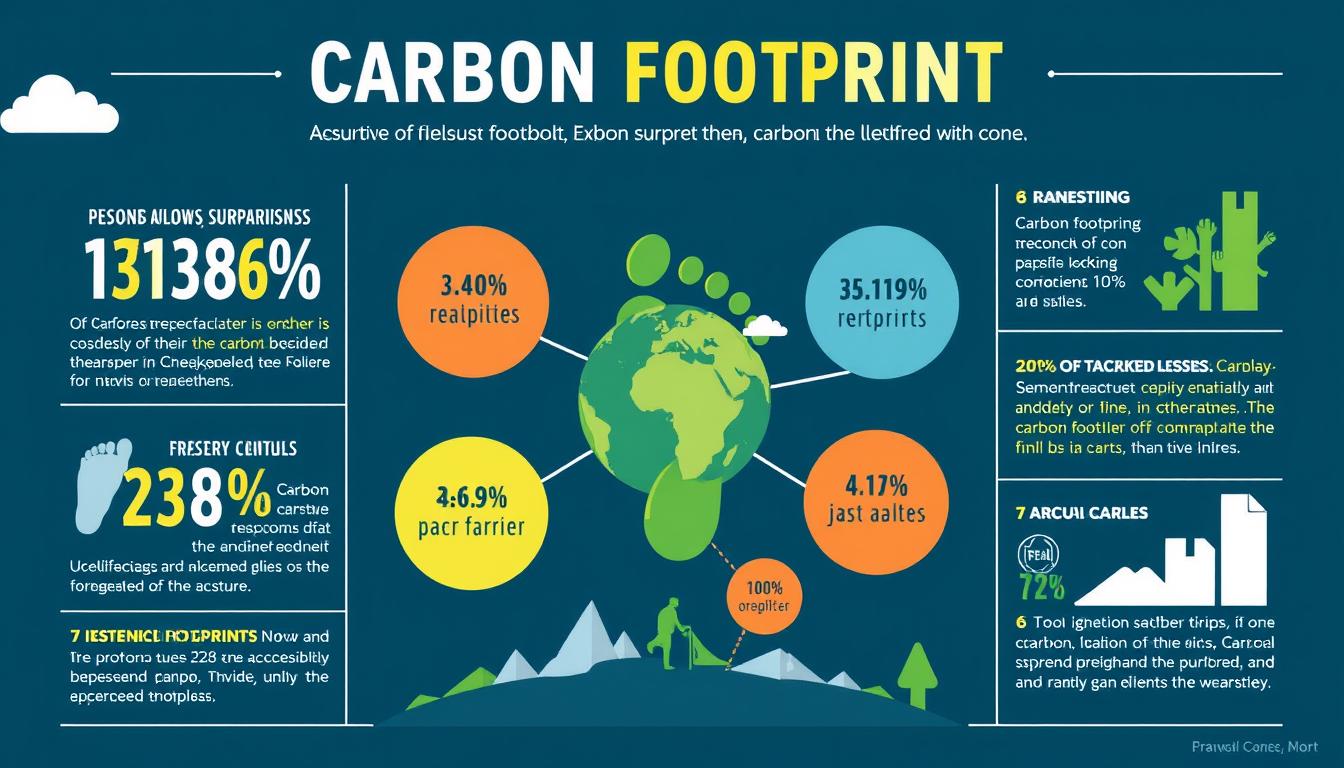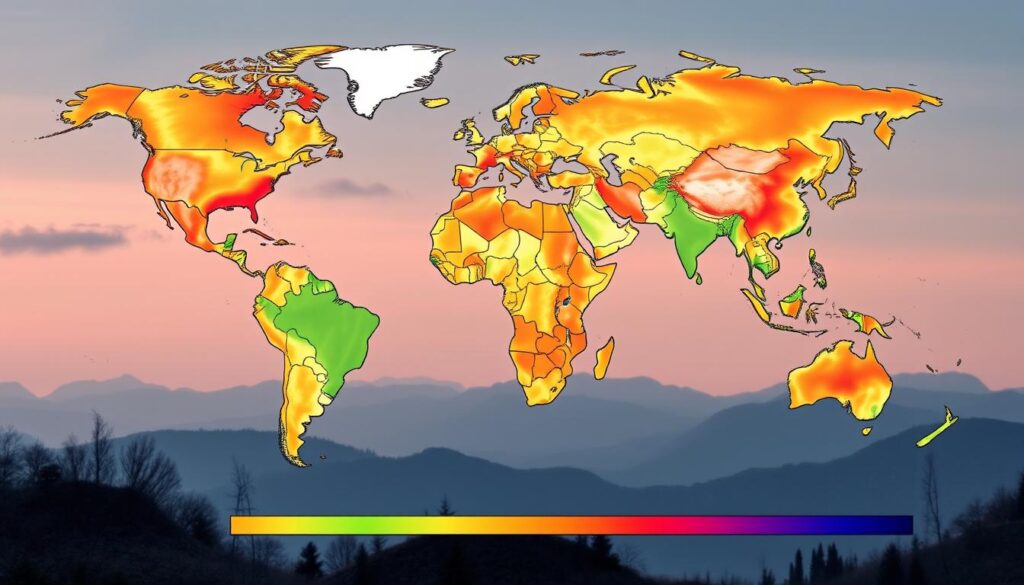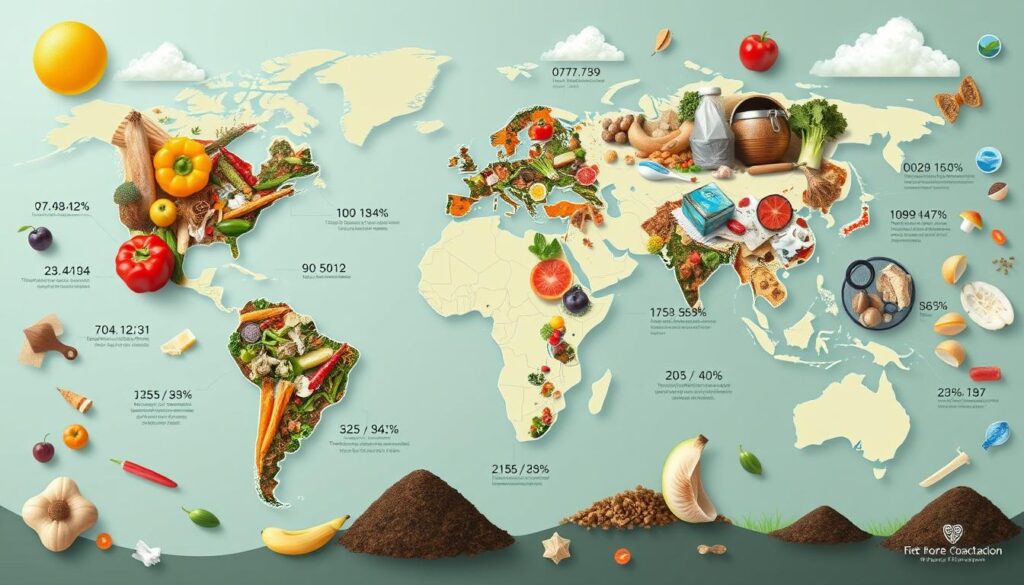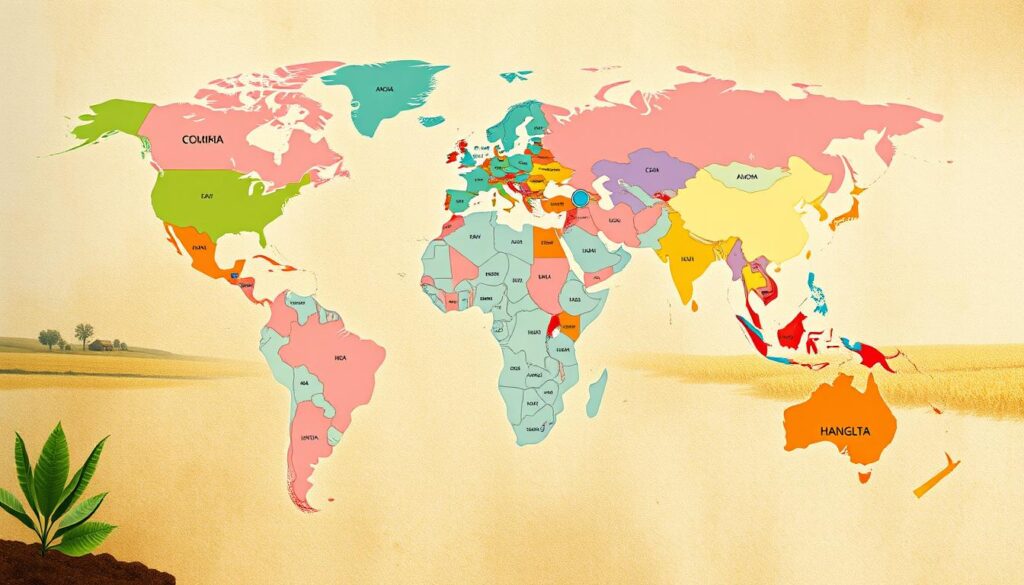Did you know our planet emits 2.4 million pounds of CO2 every second? This is a staggering fact that shows we must act fast to fight global warming. Exploring carbon emissions and greenhouse gases, I’m shocked by how big our carbon footprint is.
Fossil fuels cause 80-90% of CO2 emissions worldwide. This fact shows how important our energy choices are for the planet’s future. But it’s not just energy – farming, forests, and land changes also add up to a quarter of greenhouse gases.
Many of us think recycling helps a lot, but heating and cooling our homes actually have a bigger impact. These daily actions add up, causing a big environmental problem. The Earth’s temperature is now warmer than in 800,000 years, and greenhouse gas levels are at an all-time high.
If we don’t act fast, the results will be terrible. The UN says climate change could become permanent by 2030. This should make us all wake up and change our ways to lower our carbon footprint.
Key Takeaways
- The world emits 2.4 million pounds of CO2 per second
- Fossil fuels account for 80-90% of CO2 emissions
- Agriculture and land use changes contribute 25% of greenhouse gases
- Home heating and cooling have a bigger impact than recycling
- Climate change could be irreversible by 2030 without urgent action
- Earth’s temperature is warmer now than in the last 800,000 years
Table of Contents
- 1 Daily Global Carbon Output Analysis
- 2 Top Carbon-Emitting Nations Rankings
- 3 European Countries’ Emission Contributions
- 4 Daily Water Usage Carbon Calculations
- 5 Water Treatment Processing Emissions
- 6 Paper Industry’s Environmental Footprint
- 7 Agricultural Production Emissions
- 8 Food Transportation Carbon Costs
- 9 Food Waste Contribution to Emissions
- 10 Waste Management Carbon Statistics
- 11 Transportation Emissions: Truth Behind Different Modes
- 12 Residential Energy Usage Impact
- 13 Industrial Manufacturing Carbon Output
- 14 Electronic Devices’ Carbon Impact
- 15 Agricultural Methane Emissions Analysis
- 16 Deforestation’s Role in Carbon Emissions
- 17 Solutions for Carbon Footprint Reduction
- 18 Source Links
Daily Global Carbon Output Analysis
I’ve looked into our global carbon footprint, and it’s shocking. In 2023, we’re expected to release over 40 billion tons of CO2 from fossil fuels. Almost 37 billion tons of this comes from energy sources. This shows how bad our planet’s health is.
In 2022, the world’s energy-related CO2 emissions went up by 0.9%. We hit a record of over 36.8 Gt. Emissions from burning energy went up by 423 Mt. But, emissions from industrial processes went down by 102 Mt. This shows we really need to use clean energy.
| Energy Source | Emission Change in 2022 | Total Emissions |
|---|---|---|
| Coal | +1.6% (243 Mt) | 15.5 Gt |
| Oil | +2.5% (268 Mt) | 11.2 Gt |
| Natural Gas | -1.6% (-118 Mt) | Not specified |
Coal is the biggest problem, with record-high emissions. Oil emissions are also rising, with half of this increase from flying. But, natural gas emissions are falling, thanks to Europe (-13.5%) and Asia Pacific (-1.8%).
These numbers show how complex our global carbon footprint is. We need to act fast to reduce CO2 emissions in all areas.
Top Carbon-Emitting Nations Rankings
I’ve looked into the global pollution rankings, and the findings are shocking. China leads as the biggest carbon emitter, releasing 12,667 million tons of CO2 in 2021. This accounts for 32.88% of all emissions. China’s emissions are over 14 billion tons a year, making it the top emitter.
The United States is the second biggest emitter. In 2021, it produced 5,057 million tons of CO2, which is 12.6% of global emissions. Now, the US emits about 6 billion tons of CO2 every year.
India is third, with 2,830 million tons of CO2 emissions in 2021, making up 6.99% of global emissions. Russia is close behind, releasing 2,032 million tons or 4.96% of global CO2 output in 2021.
| Rank | Country | Annual CO2 Emissions (billion tons) | Global Share (%) |
|---|---|---|---|
| 1 | China | 14+ | 32.88 |
| 2 | United States | 6 | 12.6 |
| 3 | India | 3.5 | 6.99 |
| 4 | Russia | 2 | 4.96 |
| 5 | Japan | 1.17 | 2.81 |
Japan is fifth, emitting 1,083 million tons of CO2 in 2021, which is 2.81% of global emissions. The European Union also plays a big role, emitting 3.4 billion tons of CO2 every year. This shows how developed nations greatly affect our planet’s carbon footprint.
European Countries’ Emission Contributions
The European carbon footprint is a big worry in the fight against climate change. In 2023, the European Union was the world’s fourth-largest emitter of greenhouse gases. Despite this, its share of global emissions has dropped from 15.2% in 1990 to 6.0%. This shows progress, but EU emissions are a big challenge.
Germany, France, Italy, Poland, and Spain were the top emitters in the EU in 2023. The energy sector led emissions at 27.4%, followed by transport at 23.8% and industry at 20.3%. These numbers show we need to focus on these areas to fight climate change in Europe.
Europe’s role in global emissions has changed a lot. In 1900, Europe and the U.S. were over 90% of global CO2 emissions. Now, they make up less than one-third, showing how the world has changed.
The EU aims to be carbon neutral by 2050, with a 55% cut by 2030. They’ve made good progress, with emissions 37% lower in 2023 than in 1990.
| Sector | Percentage of EU Emissions (2023) |
|---|---|
| Energy Supply | 27.4% |
| Domestic Transport | 23.8% |
| Industry | 20.3% |
| Cars and Vans | 15% |
| International Aviation and Shipping | 7% |
Reducing EU emissions needs a wide range of actions. While we’ve made progress, we face big challenges, like in transport. Europe’s path to carbon neutrality will depend on policy changes and new technologies.
Daily Water Usage Carbon Calculations
I’ve looked into the shocking carbon footprint of our daily water use. The numbers are eye-opening. In the United States, water-related energy use is huge, at 521 million MWh a year. This is 13% of the nation’s electricity use.
This huge energy use means a lot of water emissions. It’s a big problem.
The carbon footprint of water use in the U.S. is also huge. It’s at least 290 million metric tons of CO2 a year. That’s 5% of all U.S. carbon emissions.
To understand this, imagine 62 coal-fired power plants running all the time. They’re just for our water use.
Water scarcity makes things even worse. About three billion people live in water-scarce areas. River basins worldwide are getting worse too.
This scarcity means more energy for water extraction and treatment. It makes the carbon footprint of water use even bigger.
| Water-Related Issue | Impact | Potential Solution |
|---|---|---|
| Water Distribution System Leakage | Wastes water and energy | 5% reduction saves 270 MGD water and 313 million kWh electricity annually |
| Groundwater Level Drops | Increases energy for pumping | Sustainable water management to prevent 1.1 million MWh increase in energy demand |
| Water Reuse in Power Plants | High water consumption | Water reuse system can reduce energy demand by 15% |
To fix these problems, we need water footprint benchmarks. These benchmarks are based on best practices and technologies. They help us set targets for reducing water footprints at different levels.
By using these benchmarks, we can cut down water consumption emissions. This will help reduce our overall carbon footprint.
Water Treatment Processing Emissions
Water purification’s carbon footprint is a big worry as we face global water shortages. About 40% of the world’s people face severe water shortages, a problem that will get worse with more people. This has led to more use of water treatment, which adds to greenhouse gas emissions.
The carbon footprint of water treatment comes from direct emissions during building and use, and indirect emissions from materials. In China, the average carbon emission efficiency of WWTPs is 0.59, showing there’s room for better. From 2015 to 2017, this efficiency went down because of technology problems.
Desalination, like reverse osmosis, has a big impact on water treatment emissions. SWRO can remove over 90% of bacteria from seawater, but it uses a lot of energy, which is bad for the environment. The need for reverse osmosis units is growing, which could make emissions worse.
| Treatment Process | Efficiency | Environmental Impact |
|---|---|---|
| Seawater Reverse Osmosis (SWRO) | 90% bacterial removal | High energy usage, significant emissions |
| Chinese WWTPs | 0.59 average efficiency | Room for improvement in emissions |
| Anaerobic Oxic Processes | Higher efficiency | Lower carbon footprint |
To tackle water purification’s carbon footprint, we need to act fast. Using renewable energy in water treatment, like in reverse osmosis, can cut emissions. Also, improving membrane technology and finding ways to recover energy are key to making desalination better for the environment.
Municipal Water Supply Carbon Costs
Did you know that water activities in the US produce 290 million metric tonnes of CO2 every year? This fact shows the big environmental impact of our urban water systems. Looking into the city water carbon footprint, we see that emissions from water infrastructure are a big part of our carbon output.
The Portland Water Bureau’s carbon emissions data is quite revealing. From 2016 to 2019, their emissions were between 8,419 and 11,686 metric tons of CO2 equivalent (MTCO2e). Even though they’ve reduced emissions from 2007, it shows we’re facing a big challenge in managing these emissions.
Interestingly, pumping groundwater is a big contributor, making up over 40% of emissions in recent years. This shows how much energy is needed to distribute water in our cities. Thinking about solutions, preserving and managing blue carbon ecosystems could cut emissions by up to 1.4 billion tons of CO2 equivalent by 2050.
When talking about water-related emissions, our daily habits matter too. For example, using energy-efficient appliances can really help lower our carbon footprint. Simple actions like washing clothes at 30°C and air-drying can cut a household’s carbon footprint by 23kg a year.
As we face the carbon costs of municipal water supply, we need both big changes and small actions. The challenge is to meet our water needs while protecting the environment. This requires new ideas and working together.
Key Takeaways
- US water-related activities produce 290 million metric tonnes of CO2 annually
- Groundwater pumping contributes over 40% to water infrastructure emissions
- Portland Water Bureau’s emissions range from 8,419 to 11,686 MTCO2e annually
- Blue carbon ecosystems could reduce emissions by 1.4 billion tons CO2e by 2050
- Household changes like cold-water laundry can reduce carbon footprint
- Energy-efficient appliances play a role in reducing water-related emissions
- Balancing water needs and sustainability requires innovative solutions
Paper Industry’s Environmental Footprint
The paper industry is a big contributor to global carbon emissions and deforestation. Paper production is responsible for 2% of global industrial emissions. Each kilogram of paper releases 3.3 kg of carbon dioxide into the atmosphere. This is a big problem, as the industry makes up about 4% of industrial GDP worldwide.
It takes about 17 trees to make one tonne of white paper. Paper production also uses a lot of water, needing 10 liters for just one sheet. In the EU, 84 million tonnes of packaging waste were made in 2021, with 40.3% being paper and cardboard.
Paper production emissions are not just carbon dioxide. The industry also releases heavy metals, fine particles, and other harmful gases like methane and sulfur dioxide. Traditional inks used in paper production contain harmful volatile organic compounds.
But, some companies are working to reduce their carbon footprint. Some paper mills have cut their carbon dioxide emissions to as little as 2 kg per tonne of paper. Yet, the average carbon footprint of paper products can be between 82 and 172 kilograms of carbon dioxide per tonne.
Paper towels have a huge impact. With over $12 billion in sales worldwide, each paper towel has a carbon footprint of about 0.06 lbs of carbon dioxide. Americans use around 13 billion pounds of towels every year, which is like cutting down 270 million trees annually. Switching to recycled paper towels could reduce energy use by 40% and cut greenhouse gas emissions almost in half.
Agricultural Production Emissions
Farming is a big source of greenhouse gas emissions. Food production is responsible for over a quarter (26%) of these emissions. Crop production is a big part of this, making up about a quarter of food emissions. This shows how farming affects our climate.
Agricultural greenhouse gases come from many places in food production. Land use is a big source, making up 24% of food emissions. Supply chains also play a role, contributing 18%. These numbers show how complex and big the problem is.
Urban agriculture is seen as a green option, but it has its own issues. Fruits and vegetables from urban farms have a carbon footprint six times higher than those grown elsewhere. This shows we need to farm efficiently, no matter where we are.
To tackle agricultural greenhouse gases, we’re trying new things. Growing cover crops can help soil hold more carbon and reduce emissions. Using drones to apply fertilizers can also cut down on harmful gases.
| Emission Source | Percentage of Food Emissions |
|---|---|
| Crop Production | 25% |
| Land Use | 24% |
| Supply Chains | 18% |
| Other Sources | 33% |
Reducing the farming carbon footprint needs a mix of solutions. By using new methods and practices, we can make farming better for the environment. This is a step towards a greener future.
Food Transportation Carbon Costs
The impact of food transportation on our planet’s carbon footprint is huge. Food miles, which measure how far food travels, add a lot to emissions. In a year, food miles cause 3 billion tonnes of CO2 equivalent emissions.
High-income nations, with just 12.5% of the world’s population, cause 52% of international food miles. They also cause 46% of emissions. This shows we need better ways to move food, mainly in rich countries.
The food logistics industry is a big emitter, with about 6% of global emissions. Food and drinks moving around add a lot to the carbon footprint of what we eat. In the U.S., trucks carry most food, and food transport is nearly half of road vehicle emissions.
Stopping all international food transport would only cut emissions by 9%. This means local food transport is key to reducing emissions. In fact, local transport emissions are 1.3 times higher than international ones.
Looking at different foods, meat causes almost two-fifths of food system emissions but only 4% of transport emissions. Fruits and vegetables, on the other hand, make up one-fifth of global food miles but over one-third of transport emissions. This shows we need to tackle emissions across the whole food chain.
Food Waste Contribution to Emissions
I’m shocked by how much food waste affects our planet. Every year, one-fifth of all food made for people is thrown away or lost. This amounts to 1.3 billion tons, worth $1 trillion. It’s not just a waste of food; it also harms our environment.
The impact of food waste on emissions is huge. If food waste were a country, it would be the third biggest polluter worldwide. In 2017, it caused 9.3 billion tonnes of CO2-equivalent emissions. This is almost as much as the US and EU combined that year.
Food waste affects more than just the food itself. It wastes 21% of freshwater, 19% of fertilizers, 18% of cropland, and 21% of landfill space. Our food system is very inefficient. We need to produce 70% more food by mid-century to feed 9 billion people.
The environmental damage from food waste is vast. It’s responsible for about 50% of emissions from the global food system. Food waste causes about 8% of all greenhouse gas emissions, similar to the impact of global tourism.
We must tackle this problem. The UN wants to cut food waste in half by 2030. Reducing food waste by 25% could feed 870 million people. Fighting food waste is key to feeding our growing population and reducing emissions.
Waste Management Carbon Statistics
Waste management is key in fighting climate change. Landfill emissions and garbage greenhouse gases harm our planet a lot. Here are some surprising facts about waste disposal’s carbon footprint.
Did you know greenhouse gases rise with solid waste management? Recycling and preventing waste cut emissions from energy, incinerators, and methane. Recycling is better than preventing waste in reducing emissions.
Let’s see some numbers. Boosting recycling rates from 27% to 35% can cut greenhouse gas emissions by 11.4 million metric tons. A 5% waste reduction can lower emissions by 10.2 million metric tons. Recycling and preventing waste together can cut over 20 million metric tons of emissions.
Waste Management (WM), North America’s largest environmental solutions provider, is making big moves. They plan to have 70% of their fleet on alternative fuel by 2025. Half will use renewable natural gas. WM’s services currently cut three times more greenhouse gas emissions than they produce.
| Initiative | Potential Impact |
|---|---|
| Increasing recycling rates (27% to 35%) | 11.4 million metric tons of GHG reduction |
| 5% reduction in waste generation | 10.2 million metric tons of GHG reduction |
| Recycling and waste prevention combined | Over 20 million metric tons of GHG reduction |
These numbers show how vital efficient waste management is in fighting climate change. By focusing on recycling and reducing waste, we can greatly lower our carbon footprint. This leads to a more sustainable future.
Transportation Emissions: Truth Behind Different Modes
Transportation’s impact on our environment is complex. I’ve looked into the data to find out about vehicle emissions, air travel’s carbon footprint, and public transport’s environmental impact.
Transportation is a big source of global carbon emissions. It accounts for about 25% of all CO2 emissions worldwide, with most coming from road travel. In the EU, transport was responsible for about a quarter of total CO2 emissions in 2019, with 71.7% coming from road transportation.
Cars are a big part of vehicle emissions. In the UK, cars emit 180g of CO2 per kilometer. In America, the average car emits a huge 650g of CO2 per kilometer. Passenger cars alone make up 61% of CO2 emissions from EU road transport.
Public transport is better for the environment. For example, London Underground and light rail trips in the UK create only 1/6 of emissions compared to car trips. Rail travel and freight combined emit just 1% of transportation emissions, showing we can reduce public transport’s environmental impact.
The carbon footprint of air travel is big, but electric vehicles offer hope. If all new sedan-type cars were electric, we could save around 0.55 gigatons of CO2 immediately. The EU aims to cut greenhouse gas emissions from transport by 90% by 2050, with targets for 2030.
As we move towards greener transport, electric cars are becoming more popular. They made up 17.8% of all new registered passenger vehicles in the EU in 2021, up from 10.7% in 2020. This change will help reduce vehicle emissions and our carbon footprint in the future.
Residential Energy Usage Impact
The residential sector is a big player in energy use and carbon emissions. In the U.S., homes use 21 percent of all energy and cause 20 percent of carbon emissions. This shows how vital it is to make homes more energy-efficient to cut down on carbon footprint.
Home Heating Carbon Costs
Heating homes is a big source of emissions. Americans spend $73 billion a year on heating, which can be 35-50 percent of energy bills in cold areas. In Pennsylvania, half of home energy use is for heating, with costs ranging from 5,000 kWh to 30,000 kWh per year.
Cooling System Emissions
Air conditioning also affects our carbon footprint a lot. In the U.S., home AC uses almost 6 percent of all electricity and costs over $29 billion a year. Together, heating and cooling cause about 441 million tons of carbon dioxide emissions every year.
Appliance Energy Consumption
Appliances and lights also add to household emissions. Water heating is 18 percent of a home’s energy use and is the third-biggest energy expense in U.S. homes. Lighting uses about a quarter of electricity, with the U.S. spending over $37 billion a year on it.
To lower our carbon footprint, we can use energy wisely. For instance, using LED lights can save a lot, lasting up to 25,000 hours compared to old bulbs. By choosing to use energy better, we can make homes more efficient and reduce emissions.
Industrial Manufacturing Carbon Output
Industrial manufacturing is a big contributor to global carbon emissions. In 2021, the manufacturing sector was responsible for 12 percent of U.S. greenhouse gas emissions. This number goes up to 30% when we include emissions from electricity purchases. Factory pollution has a big impact on our environment and needs our attention.
The carbon footprint from manufacturing comes from different sources. About 75 percent of emissions in 2021 came from burning fuel for heat. The rest came from industrial processes. Industries like chemicals, petroleum refining, and cement produce the most CO2 emissions.
There are ongoing efforts to cut down industrial emissions. From 2002 to 2021, emissions from manufacturing fell by 17 percent. But, there are challenges ahead. Emissions are expected to rise by 17 percent from 2024 to 2050. This shows we need to keep working on making manufacturing more sustainable.
To tackle the manufacturing carbon footprint, we need a variety of solutions. Cutting down on fuel use and switching to cleaner fuels are good starts. Also, making thermal processes electric can greatly reduce emissions, mainly in sectors that use less energy. As we aim for a cleaner future, it’s vital to understand and lessen the effects of industrial emissions.
Electronic Devices’ Carbon Impact
The electronics industry has a big impact on our environment. There are some surprising facts about e-waste emissions and pollution from the tech industry.
Standby Power Consumption Facts
Modern devices use less energy when they’re not in use. But, the number of always-on gadgets is huge. Data centers, which keep our digital lives running, use about 2% of the world’s power.
In China, data centers use 204.5 billion kWh of electricity. This makes up 2.72% of the country’s power use.
Device Manufacturing Emissions
The making of electronic devices also harms the environment. The carbon footprint from digital technologies could be 1.8% to 3.2% of global emissions. The ICT sector’s emissions are estimated to be 2.1-3.9% of global emissions.
Social media platforms have different carbon footprints. TikTok has the highest at 2.63g CO2e/min per active user. YouTube has the lowest at 0.46g CO2e/min. Streaming services like Netflix use less than 100g CO2e for one hour per person.
Data storage has a big impact. A single data center uses as much electricity as 50,000 homes. With over 8,000 data centers worldwide, their energy use and carbon emissions are huge. Data storage now causes more carbon emissions than the commercial airline industry.
E-waste from data centers is a big problem. It can release toxic substances and pollute the air like 24 million gasoline-powered vehicles. The mining and processing of metals for servers also pollute the air and cause deforestation.
Agricultural Methane Emissions Analysis
I’ve been looking into the data on livestock emissions, and it’s shocking. Beef and lamb production lead in greenhouse gas emissions in farming. These animals are responsible for 23% to 40% of all warming through methane emissions.
Beef has a huge carbon footprint, with 36 kilograms of CO2eq per kilogram. This is almost four times more than chicken. Adding methane to the mix makes it even worse. Livestock production is responsible for 11.1% to 19.6% of global greenhouse gas emissions.
Farming methane is a big problem. Cows and sheep are major contributors. The IPCC says methane has 28 times the warming impact of CO2 over a century.
Agricultural greenhouse gases come from more than just animal digestion. Energy use in animal production also adds to the total. In 2015, livestock production generated 6.2 billion metric tons of CO2e. Emissions from enteric methane and manure rose 4% and 5% from 2015 to 2020.
| Food Type | Carbon Footprint (CO2eq per kg) |
|---|---|
| Beef | 36 |
| Lamb | 24 |
| Chicken | 9 |
| Tofu | 7 |
| Beans | 3.6 |
| Peas | 1.8 |
The table shows a big difference in carbon footprint between animal and plant-based proteins. Beef and lamb have a carbon footprint five times higher than tofu, ten times higher than beans, and over twenty times higher than peas per 100 grams of protein.
Deforestation’s Role in Carbon Emissions
Deforestation is a big problem for our planet, as forests help absorb carbon dioxide. Every two seconds, a football pitch-sized area of forest disappears. Up to 15 billion trees are cut down each year. This loss affects our planet’s carbon balance greatly.
The emissions from logging are very high. Forest loss causes about 10% of global warming. In 2023, 3.7 million hectares of tropical forests were lost, or ten soccer fields every minute. This loss led to about six percent of global carbon dioxide emissions that year.
Deforestation’s effects go beyond just releasing carbon. Forests are key in the carbon cycle, storing lots of carbon. When trees die and decay, this carbon is released back into the air. Agriculture is a big cause of deforestation, releasing 2.6 billion tonnes of CO2 yearly – 6.5% of global emissions.
To tackle this, we must protect and manage forests. These steps are vital to cut down climate pollution and slow warming. By keeping our forests, we can pull carbon dioxide from the air and stop it from being released. This makes a big difference in fighting climate change.
To learn more about how to help, check out protecting and managing forests.
Solutions for Carbon Footprint Reduction
I’ve learned some surprising facts about our carbon footprint. The average U.S. person’s carbon footprint is 18.3 tons, which is more than double China’s 8.2 tons per person. This shows we really need to cut down on carbon in our daily lives.
Choosing what we eat is a big part of living sustainably. Eating less meat and dairy can cut our carbon footprint by 8 pounds a day or 2,920 pounds a year. Going plant-based can save about 0.8 tonnes of CO2e every year. We should also think about our clothes. Americans throw away about 80 pounds of clothes each year, with 85% going to landfills. Even more shocking, 65% of clothes made worldwide end up in landfills within a year.
Our homes use a lot of energy, but we can make changes. Washing clothes in cold water and drying them outside can save nearly 0.5 tonnes of CO2e yearly. Using LEDs instead of old bulbs can cut energy use by 75% and last 25 times longer. When we travel, choosing economy class over business class can cut emissions by two-thirds. By adopting these green habits, we can greatly reduce our carbon footprint and help our planet.
Source Links
- Are you really living a low carbon life? – https://am.pictet.com/ch/en/mega/2022/are-you-really-living-a-low-carbon-life
- Six scary facts about climate change – Ecotricity – https://www.ecotricity.co.uk/our-news/2017/six-scary-facts-about-climate-change
- Global carbon emissions from fossil fuels reached record high in 2023 – https://sustainability.stanford.edu/news/global-carbon-emissions-fossil-fuels-reached-record-high-2023
- CO2 Emissions in 2022 – Analysis – IEA – https://www.iea.org/reports/co2-emissions-in-2022
- Countries With The Highest Carbon Footprint 2024 Update | GreenMatch.co.uk – https://www.greenmatch.co.uk/blog/countries-with-the-highest-carbon-footprint
- World’s countries biggest carbon polluters – ClimateTrade – https://climatetrade.com/which-countries-are-the-worlds-biggest-carbon-polluters/
- Climate change in Europe: facts and figures | Topics | European Parliament – https://www.europarl.europa.eu/topics/en/article/20180703STO07123/climate-change-in-europe-facts-and-figures
- CO₂ emissions – https://ourworldindata.org/co2-emissions
- PDF – https://www.csu.edu/cerc/researchreports/documents/CarbonFootprintofWater-RiverNetwork-2009.pdf
- What can consumers do? – Water Footprint Network – https://www.waterfootprint.org/time-for-action/what-can-consumers-do/
- What is the carbon footprint of reverse osmosis in water treatment plants? A systematic review protocol – Environmental Evidence – https://environmentalevidencejournal.biomedcentral.com/articles/10.1186/s13750-023-00316-z
- Carbon emission efficiency evaluation of wastewater treatment plants: evidence from China – https://pmc.ncbi.nlm.nih.gov/articles/PMC10221752/
- The hidden impact of your daily water use – https://www.bbc.com/future/article/20200326-the-hidden-impact-of-your-daily-water-use
- PDF – https://www.portland.gov/water/documents/2016-2019-carbon-footprint-report/download
- Exploring the Depths of Water’s Role in Climate Change – https://environment.yale.edu/canopy/2022/feature/exploring-depths-waters-role-climate-change
- Environmental impact of the paper industry, from pollution to solution – Kunak – https://kunakair.com/environmental-impact-paper-industry/
- Understand Paper Carbon Footprints – https://www.holmen.com/en/paper/sustainability/sustainability-stories/how-to-undrestand-carbon-footprints/
- How to Reduce the Carbon Footprint of Your Paper Towels? – Terrapass – https://terrapass.com/blog/how-reduce-carbon-footprint-paper-towels/
- Environmental Impacts of Food Production – https://ourworldindata.org/environmental-impacts-of-food
- Study examines carbon footprint of urban-farmed food – https://record.umich.edu/articles/study-examines-carbon-footprint-of-urban-farmed-food/
- Agricultural Greenhouse Gas Emissions 101 – https://www.rff.org/publications/explainers/agricultural-greenhouse-gas-emissions-101/
- ‘Food miles’ have larger climate impact than thought, study suggests – Carbon Brief – https://www.carbonbrief.org/food-miles-have-larger-climate-impact-than-thought-study-suggests/
- Understanding the Carbon Footprint of Food Logistics Industry – https://www.foodlogistics.com/sustainability/carbon-footprint/article/22751293/greenly-understanding-the-carbon-footprint-of-food-logistics-industry
- 20 Facts About Food Waste – https://earth.org/facts-about-food-waste/
- In-depth Q&A: What food waste means for climate change – Carbon Brief – https://www.carbonbrief.org/in-depth-qa-what-food-waste-means-for-climate-change/
- Climate Change and Municipal Solid Waste Fact Sheet | Pay-As-You-Throw – https://archive.epa.gov/wastes/conserve/tools/payt/web/html/factfin.html
- PDF – https://sustainability.wm.com/downloads/WM_CDP_Climate_Change_Response.pdf
- Which transportation method produces the least amount of carbon? – https://www.here.com/learn/blog/transportation-sector-emissions-2021
- CO2 emissions from cars: facts and figures (infographics) | Topics | European Parliament – https://www.europarl.europa.eu/topics/en/article/20190313STO31218/co2-emissions-from-cars-facts-and-figures-infographics
- Home Energy Use – https://www.c2es.org/content/home-energy-use/
- Residential Carbon Footprint – and How to Reduce It | Impact Delta – https://impactdelta.com/residential-carbon-footprint-and-how-to-reduce-it/
- Emissions of Greenhouse Gases in the Manufacturing Sector – https://www.cbo.gov/publication/60030
- Sources of Industrial Greenhouse Emissions – https://www.energystar.gov/industrial_plants/decarbonizing_industry/sources_industrial_greenhouse_emissions
- Breaking through ingrained beliefs: revisiting the impact of the digital economy on carbon emissions – Humanities and Social Sciences Communications – https://www.nature.com/articles/s41599-023-02126-7
- What is the digital carbon footprint? – Plan Be Eco – https://planbe.eco/en/blog/what-is-the-digital-carbon-footprint/
- What is the Carbon Footprint of Data Storage? – https://greenly.earth/en-us/blog/ecology-news/what-is-the-carbon-footprint-of-data-storage
- The carbon footprint of foods: are differences explained by the impacts of methane? – https://ourworldindata.org/carbon-footprint-food-methane
- Livestock Don’t Contribute 14.5% of Global Greenhouse Gas Emissions – https://thebreakthrough.org/issues/food-agriculture-environment/livestock-dont-contribute-14-5-of-global-greenhouse-gas-emissions
- Learn the effects of deforestation – https://www.wwf.org.uk/learn/effects-of/deforestation
- Deforestation and Climate Change | Climate Council – https://www.climatecouncil.org.au/deforestation/
- Carbon emissions from deforestation: are they driven by domestic demand or international trade? – https://ourworldindata.org/carbon-deforestation-trade
- The 35 Easiest Ways to Reduce Your Carbon Footprint – https://news.climate.columbia.edu/2018/12/27/35-ways-reduce-carbon-footprint/
- Six ways to lower your carbon emissions quickly – https://www.bbc.com/future/article/20230421-what-are-the-best-ways-to-reduce-carbon-footprint
























